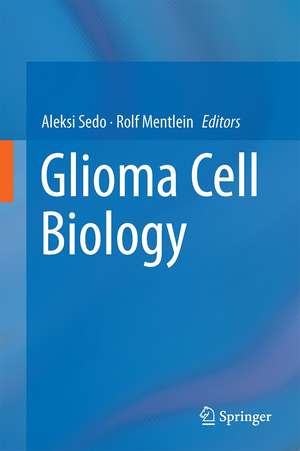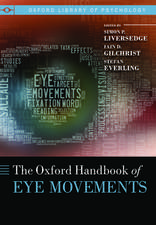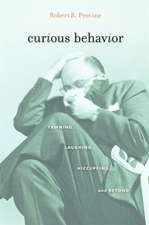Glioma Cell Biology
Editat de Aleksi Sedo, Rolf Mentleinen Limba Engleză Hardback – dec 2014
| Toate formatele și edițiile | Preț | Express |
|---|---|---|
| Paperback (1) | 799.49 lei 38-44 zile | |
| SPRINGER VIENNA – 22 aug 2016 | 799.49 lei 38-44 zile | |
| Hardback (1) | 959.36 lei 43-57 zile | |
| SPRINGER VIENNA – dec 2014 | 959.36 lei 43-57 zile |
Preț: 959.36 lei
Preț vechi: 1169.95 lei
-18% Nou
Puncte Express: 1439
Preț estimativ în valută:
183.59€ • 190.51$ • 153.45£
183.59€ • 190.51$ • 153.45£
Carte tipărită la comandă
Livrare economică 17-31 martie
Preluare comenzi: 021 569.72.76
Specificații
ISBN-13: 9783709114308
ISBN-10: 3709114306
Pagini: 500
Ilustrații: X, 468 p. 56 illus., 52 illus. in color.
Dimensiuni: 155 x 235 x 32 mm
Greutate: 0.84 kg
Ediția:2014
Editura: SPRINGER VIENNA
Colecția Springer
Locul publicării:Vienna, Austria
ISBN-10: 3709114306
Pagini: 500
Ilustrații: X, 468 p. 56 illus., 52 illus. in color.
Dimensiuni: 155 x 235 x 32 mm
Greutate: 0.84 kg
Ediția:2014
Editura: SPRINGER VIENNA
Colecția Springer
Locul publicării:Vienna, Austria
Public țintă
ResearchCuprins
The inner space: Molecular mechanisms driving the malignant phenotype of glioma cells: Cancer stem cells and glioblastoma.- Epigenetic changes in gliomas.- Signaling cascades and transcription factors driving the malignant phenotype of glioma cells.- MicroRNAs in molecular pathology of gliomas.- Autophagy in glioma cells.-
Partnership: Glioma cell partners and the tumor microenvironment: Auto- and paracrine mediators in the glioma microenvironment.- Angiogenesis in gliomas.- Immune response – gliomas-associated immunosuppression.- Microglia in gliomas: friend or foe? Glioma and Extracellular Matrix.- Glioblastomas and the special role of adhesion molecules in their invasion.- Glioma-associated proteases.- Interactions: Concepts and tools in glioma research:- Experimental models of glioma.- Models to study glioma cell invasion.
Partnership: Glioma cell partners and the tumor microenvironment: Auto- and paracrine mediators in the glioma microenvironment.- Angiogenesis in gliomas.- Immune response – gliomas-associated immunosuppression.- Microglia in gliomas: friend or foe? Glioma and Extracellular Matrix.- Glioblastomas and the special role of adhesion molecules in their invasion.- Glioma-associated proteases.- Interactions: Concepts and tools in glioma research:- Experimental models of glioma.- Models to study glioma cell invasion.
Notă biografică
Aleksi Sedo started his career as a Research Associate at the Institute of Chest Diseases in Prague, Czech Republic in 1987. He subsequently served as a Visiting Scientist and Professor at the Institute of Mutagenesis and Differentiation, which is funded by the Consiglio Nazionale de la Recherche (CNR) in Pisa, Italy. In 1996 he became an Assistant Professor of Biochemistry at the Institute of Medical Chemistry and Biochemistry, 1st Faculty of Medicine, Charles University, Prague and was appointed Associate Professor in 1997. From 1999 to 2002 Professor Sedo was a Senior Scientist at Procter and Gamble in Germany. Today he is a Professor of Medical Chemistry and Biochemistry, Head of the Institute of Biochemistry and Experimental Oncology, and Dean of the 1st Faculty of Medicine, Charles University in Prague. His research is oriented on the role of proteases in the cancer development, mostly in gliomagenesis.
Rolf Mentlein studied chemistry and biology, undertook his PhD thesis in natural chemistry (1976) and subsequently performed his postdoctoral qualification (“Habilitation”) in biochemistry at the Christian-Albrechts-University in Kiel, Germany. After post doc times and positions in Bergen (Haukeland Hospital, Norway), Osnabrück (University, Germany) and Cambridge (Babraham Institute, UK), he was appointed 1988 as a Professor for Biochemistry and Cell Biology at the University of Kiel. His main research subjects included lipases, proteases and bioactive peptides (peptide hormones, neuropeptides, growth factors and chemokines), in particular their regulation, receptors, signal transduction and functions in the brain and tumors. Among others, his research resulted in the development of new types of anti-diabetic drugs. He published about 200 original research and review articles, edited a book on neuropeptides, and is editor and reviewer for several scientific journals.
Rolf Mentlein studied chemistry and biology, undertook his PhD thesis in natural chemistry (1976) and subsequently performed his postdoctoral qualification (“Habilitation”) in biochemistry at the Christian-Albrechts-University in Kiel, Germany. After post doc times and positions in Bergen (Haukeland Hospital, Norway), Osnabrück (University, Germany) and Cambridge (Babraham Institute, UK), he was appointed 1988 as a Professor for Biochemistry and Cell Biology at the University of Kiel. His main research subjects included lipases, proteases and bioactive peptides (peptide hormones, neuropeptides, growth factors and chemokines), in particular their regulation, receptors, signal transduction and functions in the brain and tumors. Among others, his research resulted in the development of new types of anti-diabetic drugs. He published about 200 original research and review articles, edited a book on neuropeptides, and is editor and reviewer for several scientific journals.
Textul de pe ultima copertă
Gliomas are fatal diseases, but also represent good models for tumor research with the aim to eventually discover new and appropriate therapeutics against this disease. Glioma experimental research models are of help to investigate tumorigenesis (tumor stem cell theory versus "classical" opinions), tumor angiogenesis (since they are highly vascularized) and tumor invasion (since they grow without limits). In addition, they have a very special microenvironment (the brain) and limited tumor stroma cells (mainly microglia and endothelial cells). This book addresses the molecular mechanisms of the various tumor stages, describes the interaction with the tumor microenvironment and furthermore depicts experimental models for Glioma research and future therapeutic concepts. The book is composed and written for Scientists and Medical Doctors in Oncology, Neurosciences and Molecular Biology
Caracteristici
Covers genetic, epigenetic, cell- and molecular biology of glioma cells
Depicts the cell-cell interaction of glioma cells with their environment
Presents experimental research models for glioma research
Depicts the cell-cell interaction of glioma cells with their environment
Presents experimental research models for glioma research

















